In the beginning, there was the Yamaha NS-10 studio monitor. With its compact size and white woofer cone, and despite a distinct lack of bass and brittle high-end that required Kleenex over the tweeters — the specific brand of tissue was a hot topic among audio engineers — the NS-10 became a standard for nearfield reference monitors worldwide. But times and tastes changed, and the mid ’90s saw Mackie’s amazing HR824 active nearfield monitors replace the NS-10s as go-to nearfields. Sometime after, Mackie released a smaller version, the HR624, which never reached the popularity of its older sibling but was still very successful. I had a pair of these charmers for several years, and what they lacked in low end compared to 824s, they more than made up for with the same open top end and detailed mids of their big brothers. I mixed countless commercial spots on them, and liked them a lot.
Last year Mackie introduced updated versions of both HR-series speakers, namely the HR824 Mk2, and the HR624 Mk2. These are now joined by lower-cost versions of the 824 and 624 monitors with the new MR8 and MR5, respectively. Given the opportunity to test drive the MR8 and MR5, I also opted to get a pair of the HR824 Mk2’s at the same time, so I could compare red apples to green apples. Got that?
Good, because we’ve come a long way from NS-10s, I can tell you that much.
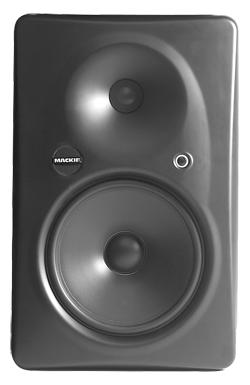
THE REPLACEMENTS MARK 2
Mackie’s HR series of active two-way studio monitors is one of the company’s biggest successes. Their replacements, the HR824 Mk2 and the HR624 Mk2, show a lot that’s changed on the outside, and a few changes on the inside too. The design team from Mackie’s sister EAW division, best known for their high-end live sound systems, played a significant role in the redesign. Manufacturing is carried out in the Far East, as it is for much of the Mackie product line these days.
Other than in woofer size, power and frequency specifications, both the HR824 Mk2 and HR624 Mk2 models are quite similar. The first thing you’ll notice is the shiny, gloss-black ‘piano’ finish. Another obvious change is that the simple rectangular baffle has been replaced by an aluminum moulding featuring a curved front and radiused corners. These rounded edges reduce diffraction, and the tweeter waveguide is moulded into the baffle so that the flare is completely smooth.
The new cabinet is slightly larger than the original HR box, but the amplifier design is basically the same. Internal bracing is used to make the cabinet more rigid and, as with the older models, the free space is filled with a porous acoustic foam to reduce internal reflections. Also carried over from the previous model is the concept of using a passive radiator (like a flat-cone speaker with no drive coil) at the rear of the cabinet, instead of a tuned port. The radiator acts like the port but has advantages at very low frequencies, where it helps prevent over-limit excursion of the woofer. The radiator is large, at 6 by 12 inches, but it is hidden by the ventilated rear-panel assembly.
The gain and frequency response of the speakers are individually adjusted during the manufacturing QC process, to reduce variations due to component tolerances and therefore achieve better matching between pairs. An individual calibration plot also comes with each speaker, which is reassuring. The low-end performance of the Mk2 is as impressive as the original, with the HR824 Mk2 covering 35Hz to 20kHz (+/-1.5dB). As with the Mk 1 series, electronic overload and short-circuit protection is built-in.
 Handling the low-end and mid-range is an 8.75-inch woofer, which has a synthetic cone, a cast-magnesium chassis and a 1.6-inch voice coil.
Handling the low-end and mid-range is an 8.75-inch woofer, which has a synthetic cone, a cast-magnesium chassis and a 1.6-inch voice coil.
On the HR624 Mk2, the woofer is a 6.7-inch driver with similar construction. The high frequencies on both are handled by a one-inch, Ferrofluid-cooled, titanium-dome tweeter, in a polymer suspension (don’t ask, but it does sound tasty). In the HR824 Mk2, the low frequency driver is powered by a 150W amplifier and the tweeter amplifier is rated at 100W, while the HR624 is powered by similar amplifiers rated at 100W and 40W respectively. The crossover has a steep 24dB-per-octave slope. The peak SPL per pair specs out at 120 dB peak at one meter for the 824 Mk2, and at 115 dB peak for the 624 Mk2, due to the slightly reduced amplifier power.
Other than the power button, all the controls are on the rear panel.
Input and power connections are under an overhang at the bottom of the metal panel. There’s a choice of RCA phono, balanced quarter-inch jack, or balanced XLR, though you can also connect an unbalanced jack or XLR. A rotary control sets the required input sensitivity, and there is a three-way slide switch to select the mains power setting — Standby, On, or Auto On mode, wherein the amplifiers turn off if no audio is detected for eight minutes, but they wake up if a level in excess of -45dB hits the input. The light ring around the power switch shows the amplifier status.
The Acoustic Space switch sets the bass level to suit room position.
‘Quarter’ is best for speakers situated near corners, ‘Half’ is for speakers placed close to one wall, and ‘Whole Space’ is best suited to speakers positioned well away from any walls. Mounting right in corners or up against a wall is not recommended anyway, due to the increased bass response you’ll get if you do. There’s also a switch to set the low-end performance, which in the case of the HR824 Mk2 offers an LF roll-off at 80Hz, 47Hz or 37Hz. Where the room is too small or too poorly bass-trapped to work well at very low frequencies, the 47Hz setting is a good option, whereas the 80Hz setting provides a reasonable emulation of the bass response of a small home music system.
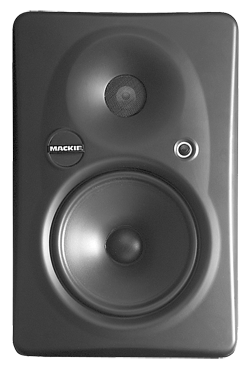 MARK 2 IN USE
MARK 2 IN USE
I have always liked the original Mackie 824s, and I have to say I expected that the Mk2 versions wouldn’t measure up. Despite the change in drivers and the switch to titanium for the tweeter dome material, the new HR824 Mk2 manages to keep essentially the same family sound as its predecessor, and though some of the high frequency detail sounds a bit less clear than before, the overall sound is still smooth and well-balanced, and it doesn’t start to sound brash unless the mix itself is over-aggressive. So if you like the original Mackie monitors, you’ll have no trouble with these.
The HR624 Mk2s incarnation actually sound pretty similar to the originals, like the HR824 Mk2, they are a little smoother at the high end. I’d say the upper-mid range was probably a bit cleaner, and the really high end a bit more pronounced, which results in a sound that is both smoother and more detailed at the same time. The maximum SPL is 5dB below that for the HR824 Mk2 and the frequency response drops off around 48Hz, but other than that the character is uncannily similar. Subjectively (once you have balanced their levels) only the depth of the bass extension of the HR824 Mk2 really sets it apart from its smaller sibling.
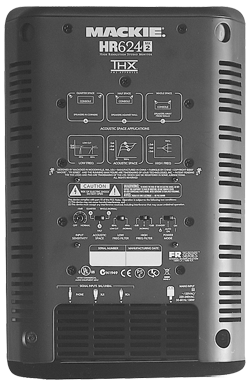 But, as I’ve mentioned, it isn’t a simple repackaging. On well-mixed material the overall sound is a touch smoother and seems less ‘in-your-face’. The mid-range retains clarity and detail at least as well as before — and possibly a little better — while the smooth, deep bass always impresses, particularly for speakers of this size. The fact that the passive radiator is at the rear means that mounting too close to walls is never a great idea, and because the bass extension is so impressive, corner-mounting is definitely to be avoided.
But, as I’ve mentioned, it isn’t a simple repackaging. On well-mixed material the overall sound is a touch smoother and seems less ‘in-your-face’. The mid-range retains clarity and detail at least as well as before — and possibly a little better — while the smooth, deep bass always impresses, particularly for speakers of this size. The fact that the passive radiator is at the rear means that mounting too close to walls is never a great idea, and because the bass extension is so impressive, corner-mounting is definitely to be avoided.
Problems can also arise in rooms that are not acoustically suitable for the reproduction of very low frequencies, though you can use the LF switch to select the middle setting. In a typical project-studio room, that can work really well, and there’s still plenty of low end. But overall these new versions are remarkably similar to the previous ones I like so very much.
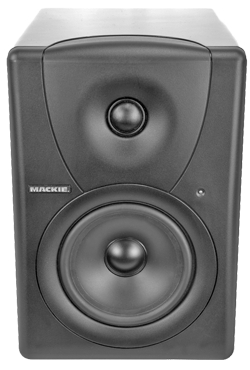 THE CONTENDERS MR5 AND MR8
THE CONTENDERS MR5 AND MR8
Mackie’s new MR5 monitors are less costly counterparts of the HR624 Mk2s, and the larger MR8s are similarly comparable with the HR824 Mk2s. Both MR models are aimed at smaller rooms where budgets are tighter but accurate monitoring is still essential.
As with the MR8s, the two-way, active MR5s have a built-in tweeter waveguide to control dispersion, as well as the usual array of acoustic controls on the rear panel — so you can tailor the response to suit your room and the location of the speakers within it. All the baffle elements surrounding the drivers are smooth to minimize diffraction, and the drivers themselves are powered by Class-A/B MOSFET amplifiers. These amps include active protection circuits and deliver 55W into the woofer and 30W into the tweeter. A 24dB/oct crossover operates at 4kHz, and an overall frequency response of 60Hz to 20kHz (+/-3dB) is quoted. There’s also more than enough level (113dB peak per pair at one meter) for a nearfield environment.
 The rear panel offers both balanced and unbalanced inputs and is also home to the rear port (there is no radiator as on the HR-series). Tucking the port around the back at least means it won’t part your hair, although it also means you can’t push the monitors right up against a wall. Balanced XLR, TRS and unbalanced RCA inputs are available, along with a knob for level control. AC power is via an IEC socket, next to which is the power switch. When the monitors are powered up, an unobtrusive white LED lights on the baffle.
The rear panel offers both balanced and unbalanced inputs and is also home to the rear port (there is no radiator as on the HR-series). Tucking the port around the back at least means it won’t part your hair, although it also means you can’t push the monitors right up against a wall. Balanced XLR, TRS and unbalanced RCA inputs are available, along with a knob for level control. AC power is via an IEC socket, next to which is the power switch. When the monitors are powered up, an unobtrusive white LED lights on the baffle.
MDF is used for the MR-series enclosures for its dense, uniform structure, with internal bracing and open-cell foam filling the internal air space to absorb reflections. All the corners are nicely rounded and the cabinet sides are finished in a black satin paint. The MR5’s drivers consist of a 5-1/4" steel-frame woofer, teamed with a one-inch, silk-domed tweeter, mounted behind a shallow waveguide.
As expected, the MR8 has a larger cabinet that is almost twice the size of the MR5. The low end is handled by an 8" steel frame driver, and the amplifier power is 100W for the woofer and 50W for the tweeter, but otherwise the construction and feature set is very similar to the MR5. The frequency range extends from 40Hz to 20kHz (+/-3dB) and there’s 3dB more level to play with. A slightly different design is used for the tweeter amplifier, while the low end benefits from a more traditional discrete design that is based around bipolar transistors. An electronic crossover with a 24dB/oct slope splits the incoming audio at 3kHz.
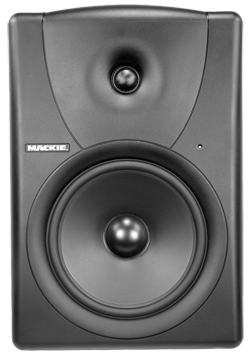 MR SERIES IN USE
MR SERIES IN USE
The MR speakers certainly look the part but at around half the price of the Mackie monitors we’ve come to know and love, what’s missing? Where are the compromises? Actually, there aren’t too many. The sound of the little MR5 is punchy, with a smooth mid-range and no harshness at the top. However, in my room with the speakers a couple of feet from the wall, the low end seemed hyped on the flat setting. Moving the tweeter up to its +2dB setting helps fix the balance but my sense is that the low end has been tuned to sound “PHAT” and the result is that the balance isn’t what it should be. There’s just too much bottom here, and I could definitely use a -2dB setting for the bass. Nevertheless, I’m impressed with the overall sound, especially at that price point. These speakers delivered detail without getting noticeably harsh or gritty at the top end. The stereo imaging is decent (as you’d expect from a small speaker), and the phantom central image is reasonably solid too.
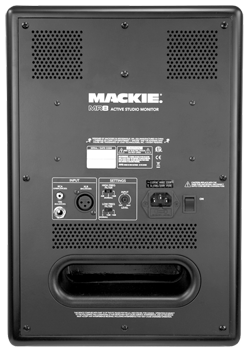 You might think that the larger MR8s — with their greater bass extension — would kill you will thump, but that actually turned out not to be the case. They reproduce the low end without effort, and there’s definitely less hype of the 80 Hz - 90 Hz region than with the MR5s. Although they’re half the price of a pair of HR824s, they’re not far off in terms of performance. The original 824s have more air on the top end, more overall clarity and better stereo imaging, but the overall character is quite similar.
You might think that the larger MR8s — with their greater bass extension — would kill you will thump, but that actually turned out not to be the case. They reproduce the low end without effort, and there’s definitely less hype of the 80 Hz - 90 Hz region than with the MR5s. Although they’re half the price of a pair of HR824s, they’re not far off in terms of performance. The original 824s have more air on the top end, more overall clarity and better stereo imaging, but the overall character is quite similar.
WRAP IT
If you like Mackie monitors, then you’ll like the HR824 and HR624 Mark 2 versions. No, they’re not identical, but I doubt there are many who will object to the subtle differences. They’re priced about the same as the originals, so they’re not cheap, but they are worth it unless you just don’t like Mackie monitors.
The newer MR series is a mixed bag. If your budget will tolerate the MR8, then they bear consideration as one of the better choices for that money. The MR5s are a bargain price-wise, but to my ear the excess low end punch was a serious distraction and a problem for me. I much preferred the more-expensive MR8.
The Mackie HR824 Mk2 studio monitors carry a suggested retail price of $779.99 each, and a pair of them will street out at about $1300 (USD). That’s about the same street price as the Mk1’s carried back in the day. The HR624 Mk2’s list at $589.99 each with a street of around $900 per pair. Neither are cheap, but the prices remain about the same as for the earlier well-loved versions.
The Mackie MR8 studio monitors carry a retail price of $329.99 each, which means a pair should street under $500 (USD). The MR5’s retail for $199.99, so a pair on the street should be around $300. No, they’re not quite the same, but they’re above average, that’s for certain. For more information worldwide, visit www.mackie.com.

